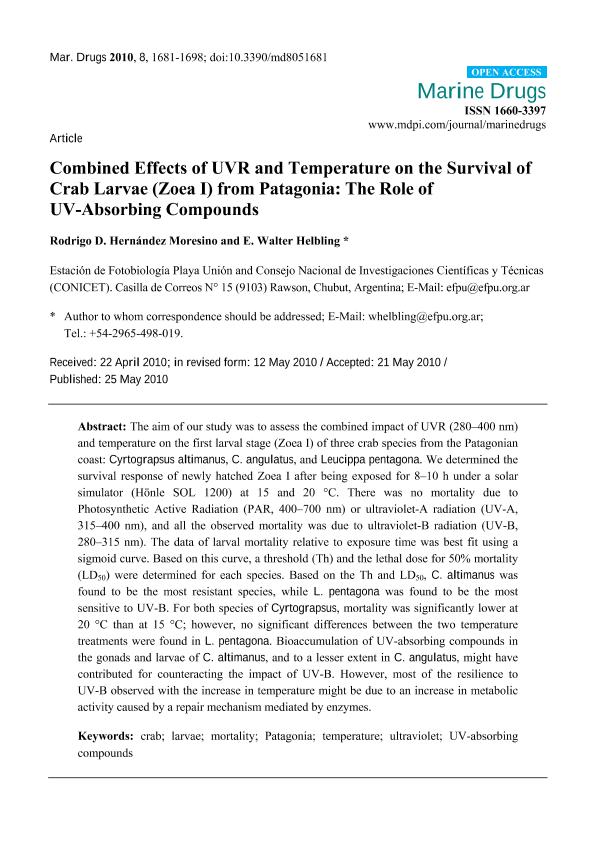Mostrar el registro sencillo del ítem
dc.contributor.author
Hernández Moresino, Rodrigo Daniel

dc.contributor.author
Helbling, Eduardo Walter

dc.date.available
2020-01-09T20:29:04Z
dc.date.issued
2010-05
dc.identifier.citation
Hernández Moresino, Rodrigo Daniel; Helbling, Eduardo Walter; Combined effects of UVR and temperature on the survival of crab larvae (Zoea I) from Patagonia: The role of UV-absorbing compounds; Molecular Diversity Preservation International; Marine Drugs; 8; 5; 5-2010; 1681-1698
dc.identifier.issn
1660-3397
dc.identifier.uri
http://hdl.handle.net/11336/94214
dc.description.abstract
The aim of our study was to assess the combined impact of UVR (280-400 nm) and temperature on the first larval stage (Zoea I) of three crab species from the Patagonian coast: Cyrtograpsus altimanus, C. angulatus, and Leucippa pentagona. We determined the survival response of newly hatched Zoea I after being exposed for 8-10 h under a solar simulator (Hönle SOL 1200) at 15 and 20 °C. There was no mortality due to Photosynthetic Active Radiation (PAR, 400-700 nm) or ultraviolet-A radiation (UV-A, 315-400 nm), and all the observed mortality was due to ultraviolet-B radiation (UV-B, 280-315 nm). The data of larval mortality relative to exposure time was best fit using a sigmoid curve. Based on this curve, a threshold (Th) and the lethal dose for 50% mortality (LD50) were determined for each species. Based on the Th and LD 50, C. altimanus was found to be the most resistant species, while L. pentagona was found to be the most sensitive to UV-B. For both species of Cyrtograpsus, mortality was significantly lower at 20 °C than at 15 °C; however, no significant differences between the two temperature treatments were found in L. pentagona. Bioaccumulation of UV-absorbing compounds in the gonads and larvae of C. altimanus, and to a lesser extent in C. angulatus, might have contributed for counteracting the impact of UV-B. However, most of the resilience to UV-B observed with the increase in temperature might be due to an increase in metabolic activity caused by a repair mechanism mediated by enzymes.
dc.format
application/pdf
dc.language.iso
eng
dc.publisher
Molecular Diversity Preservation International

dc.rights
info:eu-repo/semantics/openAccess
dc.rights.uri
https://creativecommons.org/licenses/by-nc-sa/2.5/ar/
dc.subject
CRAB
dc.subject
LARVAE
dc.subject
MORTALITY
dc.subject
PATAGONIA
dc.subject
TEMPERATURE
dc.subject
ULTRAVIOLET
dc.subject
UV-ABSORBING COMPOUNDS
dc.subject.classification
Otros Tópicos Biológicos

dc.subject.classification
Ciencias Biológicas

dc.subject.classification
CIENCIAS NATURALES Y EXACTAS

dc.title
Combined effects of UVR and temperature on the survival of crab larvae (Zoea I) from Patagonia: The role of UV-absorbing compounds
dc.type
info:eu-repo/semantics/article
dc.type
info:ar-repo/semantics/artículo
dc.type
info:eu-repo/semantics/publishedVersion
dc.date.updated
2019-11-25T18:07:34Z
dc.journal.volume
8
dc.journal.number
5
dc.journal.pagination
1681-1698
dc.journal.pais
Suiza

dc.description.fil
Fil: Hernández Moresino, Rodrigo Daniel. Fundación Playa Unión. Estación de Fotobiología Playa Unión; Argentina. Consejo Nacional de Investigaciones Científicas y Técnicas; Argentina
dc.description.fil
Fil: Helbling, Eduardo Walter. Fundación Playa Unión. Estación de Fotobiología Playa Unión; Argentina. Consejo Nacional de Investigaciones Científicas y Técnicas; Argentina
dc.journal.title
Marine Drugs

dc.relation.alternativeid
info:eu-repo/semantics/altIdentifier/url/https://www.mdpi.com/1660-3397/8/5/1681
dc.relation.alternativeid
info:eu-repo/semantics/altIdentifier/doi/http://dx.doi.org/10.3390/md8051681
Archivos asociados
